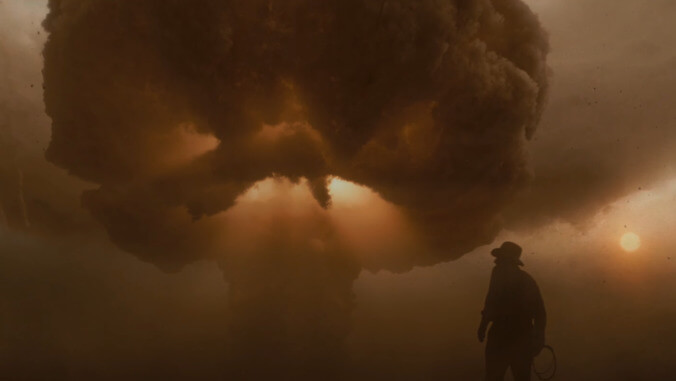No, what we’re here to defend is the movie’s most infamous—and, we’d argue, most unfairly maligned—sequence. You know the one. The meme one.
We’re here to defend nuking the fridge.
Indiana Jones 4 (2/10) Movie CLIP – Saved By the Fridge (2008) HD
For those who haven’t seen the film—or who’ve managed the not-unlikely task of forgetting the vast majority of its plot points over the last decade-and-a-half—the fridge sequence comes near the end of the movie’s first act, which sees Indy and a duplicitous sidekick played by Ray Winstone tussle with some Ruskies while Spielberg, George Lucas, and screenwriter David Koepp gleefully and figuratively smash open the iconic warehouse from the end of Raiders Of The Lost Ark. Dr. Jones finally makes his escape to a platonic ’50s suburb—only to realize, right about the time that the housewife mannequins start falling over, that he’s wandered into a test site for an imminent nuclear blast. Improvising blindly, as is his wont, Indy quickly chucks himself into a big-ass 1950s refrigerator—complete with a “lead-lined” sticker that has completely failed to quell the complaints of naysayers for the last 15 years and counting—and rides out the explosion with nary a scratch on him.
This is, admittedly, stupid.
No one’s discounting that! Lead or no, the heat from the blast—which Indy is, like, a mile from, at max—should have vaporized him basically instantly. Meanwhile, any even quasi-reasonable application of cinematic physics would have seen that refrigerator door open, post-impact, to reveal what we can only imagine would have been a brown fedora surrounded on all sides by a thick layer of archaeologist-flavored jam. All of these are valid attacks on the film’s realism, to which we can only respond: You know this is the movie franchise where they fell out of a plane using an inflatable life raft and healed bullet wounds with a magic cup, right?
But that’s a facetious response, one that ignores that the much more valid critique of the fridge nuking is not that it’s dumb, but that it’s the wrong kind of dumb—that is, that it’s not an Indiana Jones kind of dumb, a criticism you can levy at large portions of Crystal Skull. (Don’t even get us started on the way the movie’s blend of Central American mythology and good ol’ fashioned Area 51 UFO quackery attempts to create a distinctly American equivalent to the Old World religious stuff that powers the first three films. It almost works in that regard, too—but we digress!)
The something-off-ness of the fridge nuke isn’t helped by the visuals that power the moment, as Spielberg—who’s copped to being the mind behind the whole bit, even while gently pointing blame toward Lucas for some of the film’s other, sillier ideas—renders the flying appliance as a sort of CGI coffin, moving the sequence out of the realm of practical effects and into something only a cartoon character could survive. The Indiana Jones movies have always (and especially after the first movie) had a strain of goofiness to them, owing in equal parts to their forebearers in the world of old adventure serials, and Ford’s own natural comedic gift for playing over-confident loudmouths with improbably high tolerances for taking a punch. But it’s easy to see how an audience (and especially an audience who, at the risk of being reductive, were mostly children when the first three movies were released, and adults at the time of the fourth) might consider this whole sequence a fridge too far.
So, if the nuking itself is so sub-par, what’s the point of a defense? For that, we have to look at the scenes both immediately before and after it—i.e., the bits that Lucas and Spielberg are buying by coming up with this blatantly ludicrous solution to a problem of their own invention. The initial suburb sequence, for instance, is wonderfully surreal, starting with the oddity of watching Indiana Jones, 1940s adventure hero par excellence, suddenly immersed in the look and feel of 1950s suburbia. Indy looks hilariously out of place even before he starts meeting mannequins, lending a creepiness to the moment that extends beyond the inherent horror of plastic faces getting melted in nuclear fire. It’s also a fine solo comic bit for Ford, whose rising panic as he realizes just how screwed he is yet again is great, as are his pell-mell efforts to empty out his impromptu escape vehicle.
But the real payoff comes after the fridge lands. That’s when Spielberg deploys the single most affecting image of the entire movie—and the one that, in a perfect world, would have set its prevailing tone for the next two hours: The sight of Indiana Jones silhouetted against a nuke-blasted sky, standing in the shadow of a rising mushroom cloud. It’s an image so rich with subtext, so potent with potential meaning, that any halfway decent movie could have done a hundred different things with it. Crystal Skull, after some Cold War material that briefly reunites Ford with his old Fugitive co-star Neil Flynn, ignores it entirely, in favor of running off to play with monkeys and Mutts in the jungle.
And yet we can’t shake the power of it: A hero of the past, who’s spent his life collecting and preserving the artifacts of literal gods, dwarfed by the power of man’s nuclear forge. For 20 seconds, Crystal Skull isn’t just a decent Indiana Jones movie: It’s an exceptional one, one that lives up to the incredible pedigrees of the filmmakers who created it. If we have to put up with some goofy fridge physics to get that moment, well, we’ll take it, unkillable memes and all.




















![HBO teases new Euphoria, Larry David, and much more in 2026 sizzle reel [Updated]](https://img.pastemagazine.com/wp-content/avuploads/2025/12/12100344/MixCollage-12-Dec-2025-09-56-AM-9137.jpg)




















